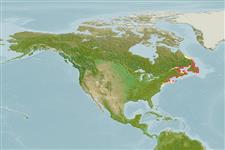Teleostei >
Salmoniformes (Salmons)
鮭形目 (Salmons) >
Salmonidae (Salmonids)
鮭科 (Salmonids) > Salmoninae
Etymology: Salvelinus: Old name for char; it is the same root of german "saibling" = little salmon (Ref. 45335); fontinalis: fontinalis meaning living in springs (Ref. 1998).
More on author: Mitchill.
Environment: milieu / climate zone / depth range / distribution range
生態學
海洋; 淡水; 半鹹淡水 底中水層性; 溯河洄游 (Ref. 120291); 深度上下限 15 - 27 m (Ref. 3899). 溫帶; 0°C - 25°C (Ref. 35682); 61°N - 34°N, 124°W - 52°W (Ref. 86798)
North America: native to most of eastern Canada from Newfoundland and Labrador to western side of Hudson Bay; south in Atlantic, Great Lakes, and Mississippi River basins to Minnesota and northern Georgia (Applachian Mountains), USA; headwaters of Chattahoochee River (Gulf basin). Introduced widely in North America and temperate regions of other continents. Several countries report adverse ecological impact after introduction.
北美洲: 從紐芬蘭到哈得遜灣的西邊大部分的加拿大東部; 南方在美國的大西洋,五大湖與密西西比河流域到明尼蘇達州與喬治亞州北部。 南美洲: 阿根廷.(參考文獻 9086) 廣泛地在其他大陸的溫帶區域中引入。 引入後的一些國家報告不利的生態衝擊。
大小 / 重量 / 年齡
Maturity: Lm ? range ? - ? cm
Max length : 86.0 cm SL 雄魚/尚未辨別雌雄; (Ref. 7248); common length : 26.4 cm TL 雄魚/尚未辨別雌雄; (Ref. 12193); 最大體重: 8.0 kg (Ref. 100229); 最大年齡: 24 年 (Ref. 72501)
背棘 (總數) : 3 - 4; 背的軟條 (總數) : 8 - 14; 臀棘: 3 - 4; 臀鰭軟條: 8 - 14; 脊椎骨: 58 - 62. Distinguished by the combination of dark green marbling on its back and dorsal fin and by the red spots with blue halos on its sides (Ref. 27547). Pelvic fins with axillary process; caudal nearly straight or with a shallow indentation (Ref. 27547). Color varies, but generally rather green to brownish on back, marked with paler vermiculations or marbling that extend onto the dorsal fin and sometimes the caudal; sides lighter than back, marked with numerous pale spots and some red spots, each of the latter surrounded by a blue halo; anal, pelvic and pectoral fins with a white leading edge followed by a dark stripe, the rest of the fins reddish (Ref. 27547). In spawning fish the lower sides and fins become red (Ref. 27547). Sea-run fish are dark green above with silvery sides, white bellies and very pale pink spots (Ref. 27547). Caudal fin with 19 rays (Ref. 2196).
區別的特徵為深綠色的大理石的組合在它的背面與背鰭了,而且藉由紅色的斑點有藍色的暈圈在它的側邊。 (參考文獻 27547) 腹鰭有腋窩的羽翼突起; 尾部的幾乎是直的或具有一個水淺的壓痕.(參考文獻 27547) 顏色改變, 但是通常相當綠色到褐色的背面, 有顯著的較灰白的蠕蟲爬跡形的裝飾或者在背鰭之上延伸的大理石紋與有時尾鰭; 側邊顏色淡的超過被有顯著的很多灰白的斑點與一些紅色的斑點的背面,每後者被一個藍色的暈圈包圍了; 臀鰭、腹鰭而且胸鰭有跟隨著一條黑的斑紋一個白色的前緣, 其它的鰭淡紅的.(參考文獻 27547) 在產卵魚下面的側邊與鰭方面變成紅色。 (參考文獻 27547) 海洋迴游的魚是深綠色的上方有銀色的側邊,白色的腹面與非常白粉紅色的斑點。 (參考文獻 27547) 尾鰭有 19個鰭條。 (參考文獻 2196)
Occurs in clear, cool, well-oxygenated creeks, small to medium rivers, and lakes (Ref. 5723, 86798). Nerito-pelagic (Ref. 58426). Anadromous in some populations (Ref. 86798). In its native range, general upstream movements have been observed in early spring, summer and late fall; downstream movements, in late spring and fall (Ref. 28546, 28548, 28549, 28550). Some fish, popularly known as salters, run to the sea in the spring as stream temperature rises, but never venture more than a few kilometers from river mouths. It may remain at sea for up to three months (Ref. 28546, 28549, 28551). Feeds on a wide range of organisms including worms, leeches, crustaceans, insects (chironomids, caddisflies, blackflies, mayflies, stoneflies and dragonflies (Ref. 5951), mollusks, fishes and amphibians (Ref. 3348, 10294); also small mammals (Ref. 1998). Stomachs of some individuals contained traces of plant remains (Ref. 1998). There are reports of introduced fish reaching 15 years of age in California, USA (Ref. 28545). Cultured for food and for stocking (Ref. 27547). Extensively used as an experimental animal (Ref. 1998). Marketed fresh and smoked; eaten fried, broiled, boiled, microwaved, and baked (Ref. 9988).
出現於清澈寒冷的,溶氧量高的小溪, 小型到中型的河 , 與湖。 (參考文獻 5723,44894,10294) 沿海-大洋性.(參考文獻 58426) 在它的原產地中,一般的向上游的運動曾經在初春, 夏天與秋天底觀察; 在春末與秋天,順流而下運動。 (參考文獻 28546,28548,28549,28550) 一些魚, 一般地知道鹹水的, 當水流溫度上升,在春天跑到海洋, 但是從不冒險嘗試超過距離河口幾公里。 它可能保持在海上超過三個月。 (參考文獻 28546,28549,28551) 吃寬範圍的生物包括蠕蟲,水蛭,甲殼動物,昆蟲 (寶刀魚, caddisflies ,黑蠅,孚游類,石蠅與蜻蜓 (參考文獻 5951)) ,軟體動物,魚與兩棲動物;(參考文獻 3348,10294) 也小的哺乳動物.(參考文獻 1998) 一些個體的腹部包含.植物殘餘物的痕跡。 (參考文獻 1998) 有被在美國加州達到 15 歲的引入的魚的報告。 (參考文獻 28545) 養殖作為食用魚而且育種使用。 (參考文獻 27547) 廣泛地用作.一隻實驗的動物。 (參考文獻 1998) 在市場上銷售燻製或新鮮.; 油炸後食用, 火烤,煮沸,微波, 而且燒烤.。 (參考文獻 9988)
Life cycle and mating behavior
成熟度 | 繁殖 | 產卵場 | 卵 | 孕卵數 | 仔魚
Courtship begins with a male attempting to drive a female toward suitable spawning gravel. A receptive female chooses a spot and digs a redd. While the female is digging, the male continues courtship activity, darting alongside the female and quivering, swimming over and under her and rubbing her with his fins; most of the time however, is spent driving off other males. When the redd is completed, the pair enter the nest and deposit eggs and milt. After spawning the female covers the eggs by sweeping small pebbles at the downstream edge of the redd upstream. Once the eggs are completely covered, she moves to the upstream end of the redd and begins digging a new redd (Ref. 27547).北美洲: 從紐芬蘭到哈得遜灣的西邊大部分的加拿大東部; 南方在美國的大西洋,五大湖與密西西比河流域到明尼蘇達州與喬治亞州北部。 南美洲: 阿根廷.(參考文獻 9086) 廣泛地在其他大陸的溫帶區域中引入。 引入後的一些國家報告不利的生態衝擊。
Page, L.M. and B.M. Burr, 2011. A field guide to freshwater fishes of North America north of Mexico. Boston : Houghton Mifflin Harcourt, 663p. (Ref. 86798)
IUCN 瀕危狀態 (Ref. 130435: Version 2024-2)
無危 (LC) (Least Concern); Date assessed: 01 August 2021
人類使用
漁業: 低經濟; 養殖: 商業性; 游釣魚種: 是的; 水族館: 公眾的水族館
工具
特別的報告
下載 XML
網路資源
Estimates based on models
Preferred temperature (Ref.
123201): 1.5 - 10.7, mean 4.5 °C (based on 47 cells).
Phylogenetic diversity index (Ref.
82804): PD
50 = 0.5000 [Uniqueness, from 0.5 = low to 2.0 = high].
Bayesian length-weight: a=0.00912 (0.00778 - 0.01070), b=3.03 (2.98 - 3.08), in cm total length, based on LWR estimates for this species (Ref.
93245).
營養階層 (Ref.
69278): 3.3 ±0.0 se; based on diet studies.
回復力 (Ref.
120179): 中等的, 族群倍增時間最少 1.4 - 4.4年 (tm=1-3; tmax=7).
Fishing Vulnerability (Ref.
59153): High vulnerability (63 of 100).
Nutrients (Ref.
124155): Calcium = 13.1 [7.5, 20.0] mg/100g; Iron = 0.34 [0.23, 0.51] mg/100g; Protein = 18.2 [17.1, 19.6] %; Omega3 = 0.922 [0.398, 2.387] g/100g; Selenium = 9.82 [2.18, 32.25] μg/100g; VitaminA = 11.1 [3.4, 32.6] μg/100g; Zinc = 0.709 [0.549, 0.870] mg/100g (wet weight); based on
nutrient studies.
